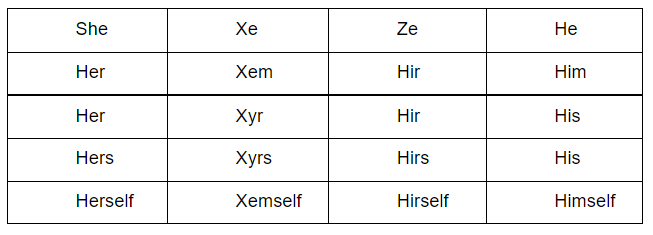What are Gender Neutral Pronouns?
Gender Neutral Pronouns (GNPs) are pronouns that don’t place a person in the gender binary (male/female) category. While some languages have gender-neutral third-person pronouns, most pronouns in English are gender-neutral (I/me/myself or you/your/yourself) until we talk about someone else. Therefore, GNPs are invariably third-person pronouns.
Who uses GNPs?
People who use GNPs feel that they reflect them more accurately than the pronouns that were assigned to them at birth. However, GNPs are not just used by trans people or by those who experience dysphoria but also by people who do not feel at home in the gender binary or assigned gender roles and hope to move away from these rigid structures. Not everyone chooses to declare their GNPs, either because they find the process of adopting uncommon pronouns a bit daunting or because they feel there’s a lack of available GNP options that match their gender identity. The important thing to remember is that pronouns are not “forever” and if someone chooses to use GNPs publicly, it is a sign that they feel comfortable to openly join those who want to shift away from the rigid binary.
Why is using GNPs more difficult for some people?
It is important to remember that GNP users who stand out as visibly non-binary or gender nonconforming have a different, more difficult experience of using GNPs than those who pass as cisgender.
Cisgender people displaying their pronouns publicly serve as allies, helping normalise GNPs as it’s easier for them to do so. That doesn’t mean that displaying one’s pronouns should be “demanded” of everyone.
How can we learn to use GNPs?
The best way to do this is to share your pronouns when meeting someone for the first time by saying “x are my pronouns” or “my pronouns are x”. This is better than outright asking someone their pronouns and putting them on the spot at the risk of outing themselves.
What gender neutral pronouns do
Though most GNPs are permanent pronouns, using them (especially they/them) can be an escape from everyday reminders of one’s assigned gender and offer a temporary breathing space for people to figure out what gender identity works for them.
How can we use GNPs?
GNPs can be divided into two categories: Singular they/them pronouns and Neo pronouns xe/xem and ze/hir.
Singular they/them pronoun: Using they/them to refer to a single person is probably the most popular gender-neutral pronoun in the English language, given that it is already commonly used to refer to one person. For example, it is generally used to denote a person we don’t know, such as, “Someone’s at the door, I wonder what they want.”
Neo-pronouns or new pronouns are used refer to someone without using the gender binary pronouns she/her or he/him. The most common dominant neo-pronouns are xe/xem (pronounced “zee” and “zem”) and ze/hir (pronounced “zee” and “here”). While neo-pronouns can be easily substituted in place of she/her or he/him pronouns without grammatical shifts, they tend to stand out in places where they are not commonly used.
Here is how we can use neo-pronouns:

They is grammatically correct
While the advantage of using the singular they is that people are familiar with it and it does not stand out, it is vulnerable to grammar arguments and can be a reason for some people to dismiss GNPs as “ridiculous”, unnecessary”, or “incorrect”. However, the singular they is grammatically correct, given that it is used by native English speakers to refer to a single person. As we recognise the changes in the way gender is perceived and experienced, the singular they tends to face resistance and labelled as grammatically incorrect.
How to use they/them instead of she/her or he/him:

Not “preferred pronouns”
A good way to avoid dismissing someone’s pronouns is to avoid referring to their pronouns as their “preferred pronouns” since that implies that someone’s gender is a “preference” rather than something they are; something they identify with.
Is someone a “sham” because they changed their pronouns more than once?
It’s hard for people to figure gender out. There’s nothing dishonest about a person who only indicated she/her as their pronouns but decides to shift to she/they or they/them. It’s their journey.
Sources:
Gender: Your Guide. Lee Airton, PhD
“Gender Pronouns”. The LGBT Resource Centre










